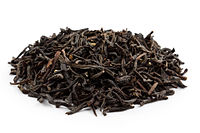
Photo from wikipedia
Although aged fragrance is the most outstanding quality characteristic of dark tea, its formation still is not much clear. Thus, the volatiles of Qingzhuan tea (QZT) during the whole post-fermentation… Click to show full abstract
Although aged fragrance is the most outstanding quality characteristic of dark tea, its formation still is not much clear. Thus, the volatiles of Qingzhuan tea (QZT) during the whole post-fermentation process were investigated at an industrial scale. The results showed that most of volatiles increased during pile-fermentation of QZT and weakened during aging storage, but some new volatiles were produced through aging storage. Hexanal, (E)-2-hexenal, (E)-2-decenal, 2,6,6-trimethyl-1-cyclohexene-1-carboxaldehyde, heptanal, (E)-2-octenal, (R)-5,6,7,7a-tetrahydro-4,4,7a-trimethyl-2(4H)-benzofuranone, ionone, 2-heptanone, 3-ethyl-4-methyl-1H-pyrrole-2,5-dione, (R,S)-5-ethyl-6-methyl-3-hepten-2-one, cis-5-ethenyltetrahydro-5-trimethyl-2-furanmethanol, and linalool generated by pile-fermentation should be the basic volatiles of aged fragrance in QZT, and 4-(2,4,4-trimethyl-cyclohexa-1,5-dienyl)-but-3-en-2-one, 6-methyl-5-heptene-2-one, safranal, guaiene, trans-2-(2-propynyloxy)-cyclohexanol, nonanal, and 4-(2,6,6-trimethyl-1-cyclohexen-1-yl)-2-butanone formed during aging storage should be the transformed volatiles of aged fragrance in QZT, which together constitute the characteristic components of aged fragrance. Notably, 4-(2,6,6-trimethyl-1-cyclohexen-1-yl)-2-butanone, 6-methyl-5-heptene-2-one, and safranal were selected as the key volatiles of QZT. These results contribute to understand better the formation of agedfragrance in dark tea.
Journal Title: Food chemistry
Year Published: 2020
Link to full text (if available)
Share on Social Media: Sign Up to like & get
recommendations!